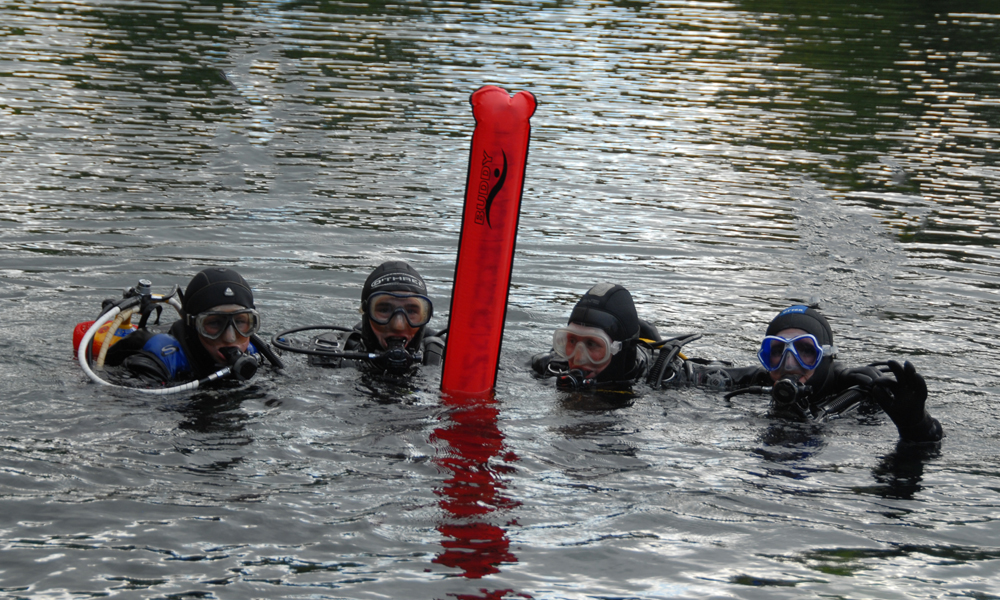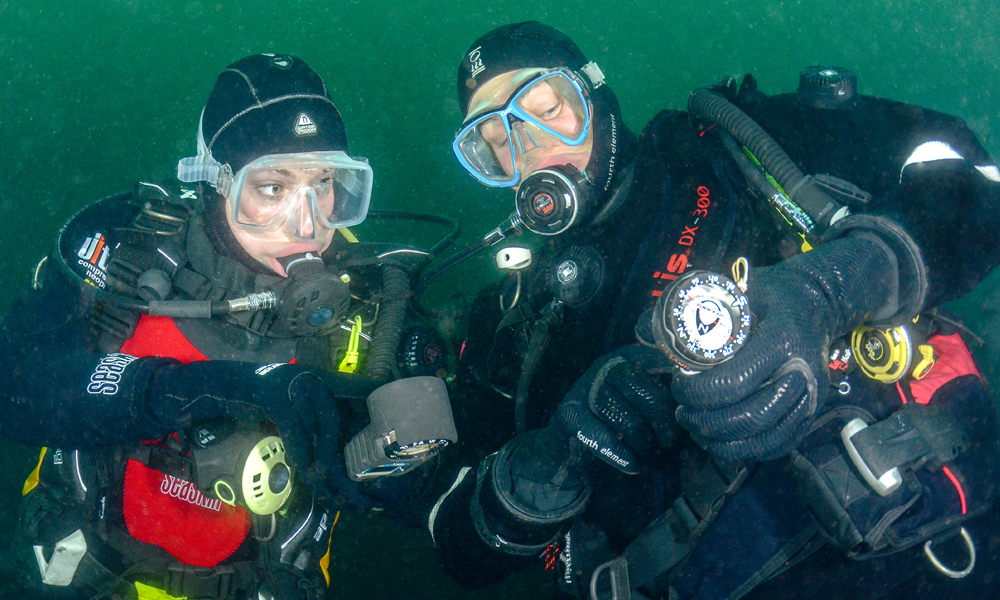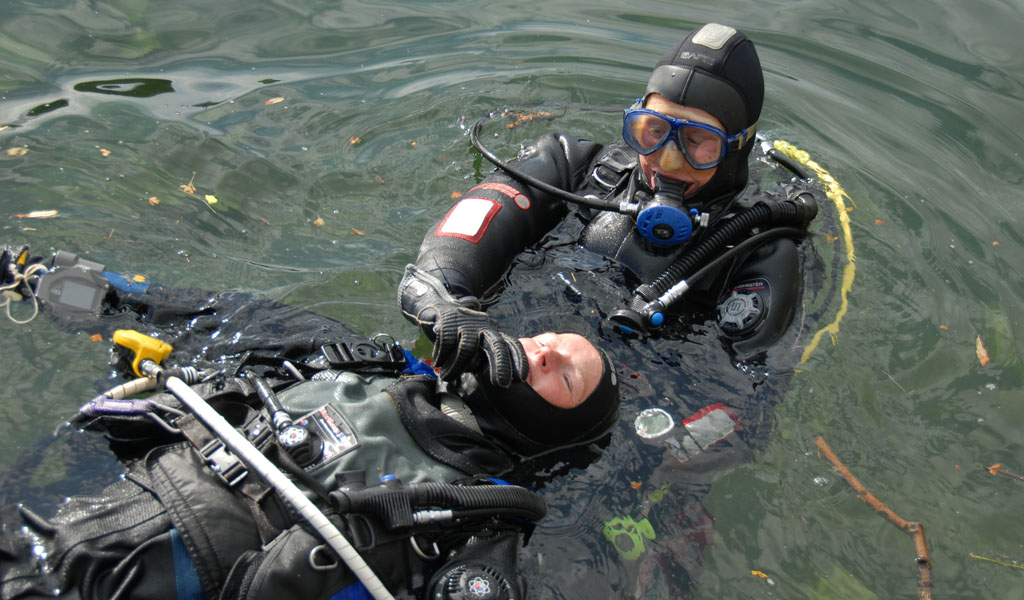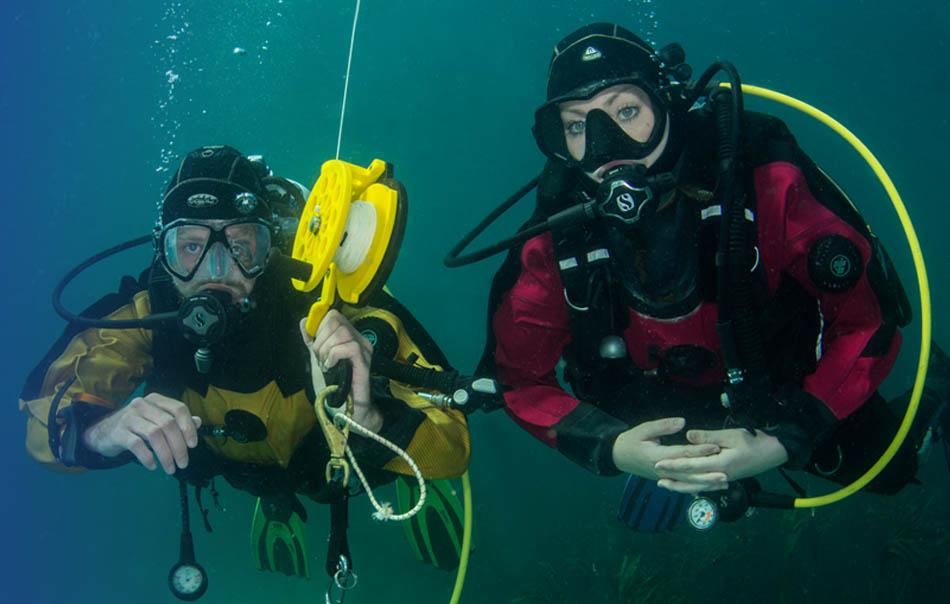
Congratulations! National Instructor Marg Baldwin welcomes BSAC Ocean Divers to the next step with her top tips for success with Sports Diver.
Becoming a BSAC Sports Diver is about expanding your practical diving abilities, rescue skills and the development of your theory knowledge: you’ll be introduced to different equipment and will consider diving in various environments.
Preparation for longer and, should you choose, deeper dives, will include more detail on gas management and the use of nitrox breathing mixes. A review of the decompression tables covers planning decompression dives and use of the tables to plan dive series involving changes in altitude.
Developing buddy diving skills also features in the course – ranging from dive leading to a review of rescue skills including alternative-supply ascents and controlled buoyant lifts. How to assist and recover an injured buddy on to the shore or a boat and the giving rescue breaths are all practised.
Sports Diver is a wonderful point from which to take your diving skills further. It opens the way to many Skill Development Courses including mixed gas diving, rebreather diving or taking the first steps to becoming an instructor. So hopefully I’ve wetted your appetite, and here are my top tips for smashing your Sports Diver training.
1. Practice your skills
Before moving on to any new or more advanced training it is always good to consider what you have achieved so far. How good is your mask clearing: can you accomplish it with confidence and ease? Is your ability to hover (good buoyancy) up to scratch, or does it need a bit more polish? Look closely at your personal skills and use your Sports Diver experience dives and lesson sessions to develop them further.
2. Line up theory with practice
If possible follow theory learning with practice, practice, practice. For example, in an ideal world you would do the theory session on equipment and techniques and then plan to do the dives that involve use of a surface marker buoy, line-laying and deployment of a delayed surface marker buoy. This isn’t always possible, so if there is a gap between a theory session and being able to put the skills into practice get out your student work book and re-read the lessons.

Review your Sports Diver theory knowledge with the online quizzes. Check them out now
3. Bring your Qualification Record Book to all training sessions and dives
I like to sign up skills and lessons successfully achieved there and then. When introduced to a new student, one of the first things I do is look at their QRB and the dives recorded in their log book. A blank QRB and being told “I have done the lessons, but I didn’t get them signed” fills me with horror. This situation can delay progress. Do take responsibility for getting your QRB and log book completed.
4. Go shopping
As a qualified diver, now is the time to start becoming self-sufficient with your equipment. Focus on personal items such a suit (dry or semi-dry) and possibly a computer. Finding a suit that fits and is suitable for your planned diving, takes time. Remember, an ill-fitting suit or one that just doesn’t feel right can be a safety issue.
Having your own computer gives you a valuable record of your dive details and depending on the computer model, your dive profile. Recording such details helps you analyse how you have performed on a dive and assists with your on-going development. Divers are usually willing to share their thoughts on their choice of computer. Seek advice, but also do your own research and make your own informed decision.
Check out BSAC's kit checklists
5. Excel at underwater navigation
At any level, it is great to have confidence in your ability to successfully use a combination of compass and underwater features to find your way around. Compass use on land; swimming on the surface and using a compass underwater all feature in Sports Diver training. Having successfully completed the training, don’t just leave it at that. Practice more: set yourself some challenges to make sure you really can use a compass.

Review your Sports Diver theory knowledge with the online quizzes. Check them out now
6. Make like a pike
If you visit an inland site, look out for the pike: they will give you an excellent demonstration of good buoyancy and trim. Throughout your dives continue to practice this core skill of diving. Remember, every time you change equipment, for example using a different suit or undergarment, do a weight check at the start of the dive.
You have practiced adjusting buoyancy by breathing, as well as putting small bursts of air into your buoyancy compensator or your drysuit. Now start thinking about your positioning and trim. You may need to move your weight around to help you stay horizontal and streamlined. Doing tasks such as line laying can easily distract a diver from maintaining good buoyancy. If this happens, acknowledge it and analyse what went awry with your instructor or buddy before you try again. Having resolved any problems, keep practising and don’t forget to make a note in your log book of how much weight you have been carrying and its position.
7. Be a sought-after buddy
Consistently and actively engage in dive planning; be attentive to your buddy’s interests and thoughts for a dive and guess what, chances are they will respond in a similar manner. Best of all worlds, your dives will be of interest to you both. Throughout any dive communicate with your buddy; point out things of interest, be tolerant when they wish to stop and look at something in detail. Remember to monitor depth, time and gas. Make sure your diving skills and your equipment are the best they can be. After any dive discuss and share what you have experienced with your buddy.
8. Polish your rescue skills
You already know that understanding varied conditions on dive sites is important. Anticipation, planning and awareness by divers can be key to preventing problems and can help us to prepare to give assistance should a problem arise. Sports Diver training develops your diver rescue abilities and introduces Basic Life Support. This sounds quite serious and it is. It can also be serious fun. Practising the recovery of divers into boats, as I have often seen, can reduce all involved to much hilarity. Common sense and the need for practice does prevail but we learn much more if it’s fun.

Review your Sports Diver theory knowledge with the online quizzes. Check them out now
9. Try different diving environments
Planning your training dives so that you experience of a range of different diving environments is essential to achieve the Sports Diver qualification, treat this requirement as a positive challenge to widen your diving opportunities and to build your experience in the local conditions where you are likely to continue diving. As a ‘sought after buddy’ you are likely to get many opportunities to go diving. Use every dive to enjoy yourself, continue with your own development and become a diving role model.
Opportunities abound, wreck diving is ideal for using a shot line and laying a line to make sure you can get back to the shot. Take the initiative and suggest a wreck of suitable depth and location. Do your homework: find out the history of the wreck and how it came to be underwater. With research a wreck dive can take on a whole different meaning and be so much more enjoyable and rewarding. Without it, you could be diving on what appears to be a tangled lump of metal and doing some skills, which could be boring.
10. Think about gas
One theory session introduces the subject of carrying more than one cylinder to ensure you have sufficient breathing gas plus a reserve. Pony cylinders, and twin cylinders are all discussed. A pony cylinder is a straightforward way of carrying an independent back-up gas supply. If your future plans include decompression diving the gas capacity of a pony cylinder configuration will be inadequate. After successful completion of Sports Diver including the depth progression, you could consider the Twin-Set Diver Skill Development Course.
If you want to extend your time underwater without the need for decompression stops, start looking at the options available when using 32 per cent and 36 per cent nitrox mixes in the nitrox decompression tables. Don’t overlook the need to stay within the maximum operating depth and to monitor your oxygen exposure during these dives.
11. Allow sufficient time for depth progression
Sports Diver training dives are no deeper than 20 metres. Once these dives are successfully completed, a next step can be to extend your depth capability to 35m. Depth progression is not just about doing three dives; one each to 25m, 30m and 35m. Be prepared to do more than one dive to each depth.
Such practice will help to build your ability in deeper diving. Make sure you understand the potential for nitrogen narcosis and the increased gas consumption at depth. Dive planning is very much part of all diving and takes on a greater importance for deeper diving. Such planning needs to include: the dive purpose and route; appropriate and correct time management; use of stops; calculation of gas required using the rule of thirds; availability and use of suitable equipment.
Having planned the dive, the dive plan must be followed. As after any dive, discuss how it went with your buddy or instructor, be constructive and honest. If repeating the dive before progressing any further is thought appropriate, then willingly repeat the dive.
Read more on Dive Planning and Management
12. Embrace dive management
Dive management is not just about having a log sheet and logging divers in and out. You need to know about the site and the prevailing conditions. This can take you into knowing about weather and sea conditions. You will need to know the individual dive plans. Who knows what you can learn from this – perhaps some ideas for your own future dives. On a more serious note, acting as Assistant Dive Manager will heightened your awareness of the need for safety at all times.
Being qualified to dive to 35m is an asset if you are planning a diving trip abroad. Do allow yourself sufficient time to complete the training and qualification required. Remember Branch Instructors are volunteers giving their time to teach members. Find out their availability for training, create a plan with dates and times with them and do your best to stick to the plans.
If a training plan is not coming together for whatever reason – think of other ways. But don’t leave it until the ‘last minute’ before a planned diving trip. If necessary, contact your Regional Coach they have access to many different levels of Instructor resources. Another option is to use a BSAC Centre. You will have to pay for the instructor’s time but before you ‘blanch’ at the price and run in the opposite direction, check out what is included and reflect on the value of the training you have already received through your branch. Food for thought.
Learning Curve article from SCUBA issue 81
Let us help you find your local BSAC club
Send your postcode to hello@bsac.com and we'll help you find the right scuba club for you. Or if you fancy a chat call us 0151 350 6226 (Mon - Fri, 9 - 5:30).

 Author: Marg Baldwin | Posted 06 Feb 2019
Author: Marg Baldwin | Posted 06 Feb 2019



